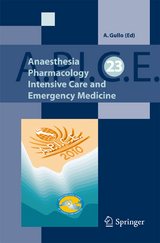Anaesthesia, Pharmacology, Intensive Care and Emergency A.P.I.C.E.
Advances in intensive and critical care medicine occur rapidly. Innovation, training and research are the pillars that support a process deriving from basic science and multiprofessional/multidisciplinary interventions. The APICE 2010 Yearbook highlights several innovations for optimising prevention and management measures for the critically ill by integrating diagnostic procedures with pharmacological and technological options. Considering that cerebral, respiratory, cardiovascular, renal and metabolic dysfunctions occurring during serious illnesses or syndromes represent risk factors for patient survival, the final goal remains multifaceted: to improve standards and quality of care; to introduce the expanding concept of clinical governance and professionalism; to focus on the importance of ethical principles for establishing a process of patient-centered and evidence-based care. For these reasons, medical professionals must reach a consensus regarding the importance of continuing medical education.
Continuing Medical Education: Can I Think what I Read?.-Clinical Pharmacology: Pharmacological Manipulation in ICU.- Kidney: Renal Injury.- Ventilation: Adult and Paediatric: Respiratory Mechanics: Principles, Utility and Advances. Capnometry/capnography in Prehospital Cardiopulmonary Resuscitation. Weaning from Mechanical Ventilation. Ventilatory Strategies in Acute Lung Injury. Mechanical Ventilation beyond the PICU.- Cardiovascular Monitoring: The NEXFIN Monitor – A Totally Non-Invasive Cardiac Output Monitor. Doppler Echocardiography in ICU Patients: Does It Improve Outcome?.- Management of Cardiac Arrest: Mild Therapeutic Hypothermia after Cardiac Arrest. Nasopharyngeal Cooling during Cardiopulmonary Resuscitation. “Amplitude Spectrum Area” as a Predictor of Successful Defibrillation.- Advances in Experimental and Clinical Research: Physiopathology and Severity of Post-Resuscitation Myocardial Dysfunction: Effects of Sodium-Hydrogen Exchanger Isoform-1 (NHE-1) Inhibitors and Erythropoietin. Experimental Treatment for Preservation of Mechanically Competent Cardiac Activity following Cardiac Arrest. Erythropoietin Facilitates Return of Spontaneous Circulation and Survival in Victims of Out-of-Hospital Cardiac Arrest.- Infections, Sepsis and Organ Dysfunction: Pathophysiology of Resistance amongst Aerobic Gram-negative Bacilli in Particular Acinetobacter Species. What Have we Learned from the Surviving Sepsis Campaign? Source Control. Immunoglobulins in Sepsis. Extracorporeal Endotoxin Removal in Sepsis.- Perioperative Medicine: Perioperative Medicine – An Introduction. Neuraxial Analgesia for Caesarean and Vaginal Delivery and Childhood Learning Disabilities. Off-label Drugs in Perioperative Medicine: Clonidine.- Spinal Cord Stimulation. Cost Effectiveness of Spinal Cord Stimulation inManagement of Severe Angina.- Spinal Cord Stimulation: Clinical Assessment and Diagnostic Procedures in Neurotrauma.- Disaster Medicine: Disaster Preparedness. Medical Emergency Response in Toxicological Mass Casualty.- Quality of Care: Telemedicine to Improve Care in the Critically Ill. Professionalism, Quality of Care and Pay-for-Performance Services.
| Zusatzinfo | 380 p. |
|---|---|
| Verlagsort | Milan |
| Sprache | englisch |
| Maße | 155 x 235 mm |
| Themenwelt | Medizin / Pharmazie ► Medizinische Fachgebiete ► Anästhesie |
| Medizin / Pharmazie ► Medizinische Fachgebiete ► Intensivmedizin | |
| Schlagworte | critical care • Emergency Medicine • hypothemia • Intensive care |
| ISBN-10 | 88-470-2013-1 / 8847020131 |
| ISBN-13 | 978-88-470-2013-9 / 9788847020139 |
| Zustand | Neuware |
| Haben Sie eine Frage zum Produkt? |
aus dem Bereich




